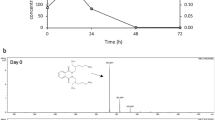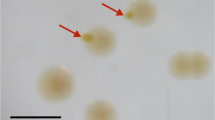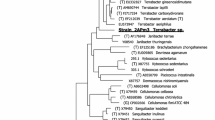Abstract
During synthrophic growth of Hydrogenophaga palleronii (strain S1) and Agrobacterium radiobacter (strain S2) with 4-aminobenzene sulfonate (4ABS) only strain S1 desaminates 4ABS by regioselective 3,4-dioxygenation. The major part of the metabolite catechol-4-sulfonate (4CS) is excreted and further metabolized by strain S2. Although both organisms harbour activities of protocatechuate pathways assimilation of the structural analog 4CS requires first of all enzyme activities with broader substrate specificity: protocatechuate 3,4-dioxygenase and carboxymuconate cycloisomerase activities were identified which in addition to the natural substrates also convert 4CS requires first of all enzyme activities with Carboxymethyl-4-sulfobut-2-en-4-olide (4SL) was identifed as a metabolite. Its further metabolism requires a desulfonating enzyme which eliminates sulfite from (4SL) and generates maleylacetate. Convergence with the 3-oxoadipate pathway is catalyzed by a maleyl acetate reductase, which was identified in cell-free extracts of both organisms S1 and S2. Characteristically, only strain S1 can oxidize sulfite and thus contributes to the interdependence of the two bacteria during growth with 4ABS.
Similar content being viewed by others

References
Bradford MM (1976) A rapid and sensitive method for the quantitation of microgram quantities of protein utilizing the principle of protein-dye binding. Anal Biochemistry 72: 248–254
Cook AM, Leisinger T (1991) Desulfonation of aromatic compounds. Internat. Symp. Environmental biotechnology I (Royal Flemish Society of Engineers. Ostend, Belgium), 115–122
Da Fonseca-Wollheim F, Bergmeyer HU, Gutman I (1974) Ammoniak. In: Bergmever HU (eds) Methoden der enzymatischen Analyse, 3rd edn. Verlag Chemie, Weinheim pp 1850–1853
Dorn E, Knackmuss H-J (1978) Chemical structure and biodegradability of halogenated aromatic compounds. Substituent effects on 1,2-dioxygenation of catechol. Biochem J 174: 85–94
Feigel BJ, Knackmuss H-J (1988) Bacterial catabolism of sulfanilic acid via catechol-4-sulfonic acid. FEMS Microbiol Lett 55: 113–118
Gaal AB, Neujahr HY (1979) Metabolism of phenol and resorcinol in Trichosporon cutaneum. J Bacteriol 137: 13–21
Hayaishi O, Katagari M, Rothberg S (1957) Studies of oxygenases. Pyrocatechase. J Biol Chem 229: 905–920
Herbert RB, Holliman FG (1964) Aeruginosin B — a natural occurring phenazinesulfonic acid. Proc Chem Soc, p 19
Johnston JB, Murry K, Cain RB (1975) Microbial metabolism of aryl sulphonates. A reassessment of colorimetric methods for the determination of sulphite and their use in measuring desulphonation of aryl and alkylbenzene sulphonates. Antonie van Leeuwenhoek 41: 493–511
MacDonald DL, Stanier RY, Ingraham JL (1954) The enzymatic formation of β-carboxymuconic acid. J Biol Chem 210: 809–819
Nörtemann B, Baumgarten J, Rast HG, Knackmuss H-J (1986) Bacterial communities degrading amino- and hydroxynaphthalene-2-sulfonates. Appl Environ Microbiol 52: 1195–1202
Nozaki M (1970) Metapyrocatechase (Pseudomonas). Methods Enzymol 17A: 522–525
Ornston LN (1966a) The conversion of catechol and protocatechuate to β-ketoadipate by Pseudomonas putida. II. Enzymes of the protocatechuate pathway. J Biol Chem 241: 3787–3794
Ornston LN (1966b) The conversion of catechol and protocatechuate to β-ketoadipate by Pseudomonas putida. III. Enzymes of the catechol pathway. J Biol Chem 241: 3795–3799
Ornston LN, Stanier RY (1964) Mechanism of β-ketoadipate formation by bacteria. Nature 204: 1279–1283
Ornston LN, Stanier RK (1966) The conversion of catechol and protocatechuate to β-ketoadipate by Pseudomonas putida. I. Biochemistry. J Biol Chem 241: 3776–3786
Pieper DH, Engesser KH, Knackmuss H-J (1989) Regulation of catabolic pathways of phenoxyacetic acids and phenols in Alcaligenes eutrophus. Arch Microbiol 151: 365–371
Quilico A (1927) Azione dell'acido amminosolfonico sui difenoli. Gaz Chim Ital 57: 793–802
Schlömann M, Knackmuss H-J (1990) Enzymatic conversion of 4-fluoromuconolactone, a metabolite of bacterial 4-fluorobenzoate degradation. 90th Annu Meet Amer Soc Microbiol K-11, p 221
Schlömann M, Fischer P, Schmidt E, Knackmuss H-J (1990) Enzymatic formation, stability, and spontaneous reactions of 4-fluoromuconolactone, a metabolite of the bacterial degradation of 4-fluorobenzoate. J Bacteriol 172: 5119–5129
Schmidt E, Knackmuss H-J (1980) Chemical structure and biodegradability of halogenated aromatic compounds. Conversion of chlorinated muconic acids into maleylacetic acid. Biochem J 192: 339–347
Spector T (1978) Refinement of the Coomassie blue method of protein quantitation. A simple and linear spectrophotometric assay for <0.5 to 50 μg of protein. Anal Biochem 86: 142–146
Stanier RY, Ingraham JI (1954) Protocatechuic acid oxydase. J Biol Chem 210: 799–808
Walsh TA, Ballou DP (1983) Halogenated protocatechuates as substrates for protecatechuate dioxygenase from Pseudomonas cepacia. J Biol Chem 258: 14413–14421
Wheelis ML, Palleroni NJ, Stanier RY (1967) The metabolism of aromatic acids by Pseudomonas testosteronii and P. acidovorans. Arch Microbiol 59: 302–314
Willems A, Busse J, Goor M, Pot B, Falsen E, Jantzen E, Hoste B, Gillis M, Kersters K, Auling G, De Ley J (1989) Hydrogenophaga, a new genus of hydrogen-oxidizing bacteria that includes Hydrogenophaga flava comb. nov. (formerly Pseudomonas pseudoflava and “Pseudomonas carboxydoflava”) and Hydrogenophaga taeniospiralis (formerly Pseudomonas taeniospiralis). Int J Syst Bacteriol 39: 319–333
Author information
Authors and Affiliations
Rights and permissions
About this article
Cite this article
Feigel, B.J., Knackmuss, HJ. Syntrophic interactions during degradation of 4-aminobenzenesulfonic acid by a two species bacterial culture. Arch. Microbiol. 159, 124–130 (1993). https://doi.org/10.1007/BF00250271
Received:
Accepted:
Issue Date:
DOI: https://doi.org/10.1007/BF00250271



